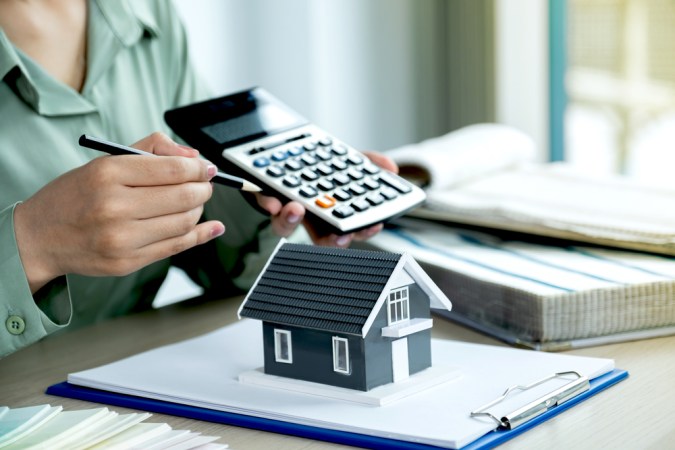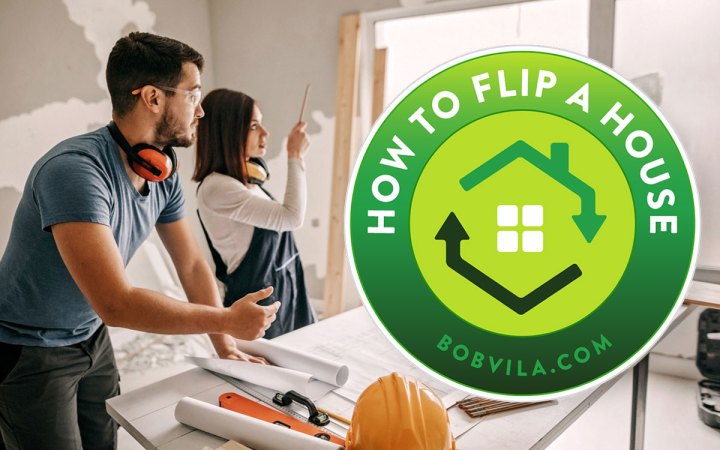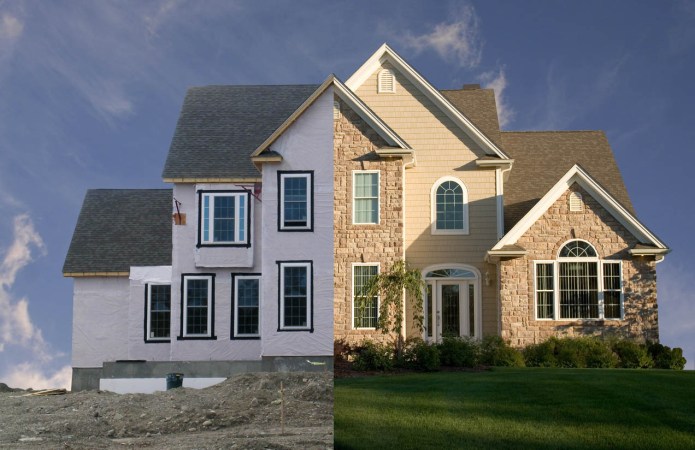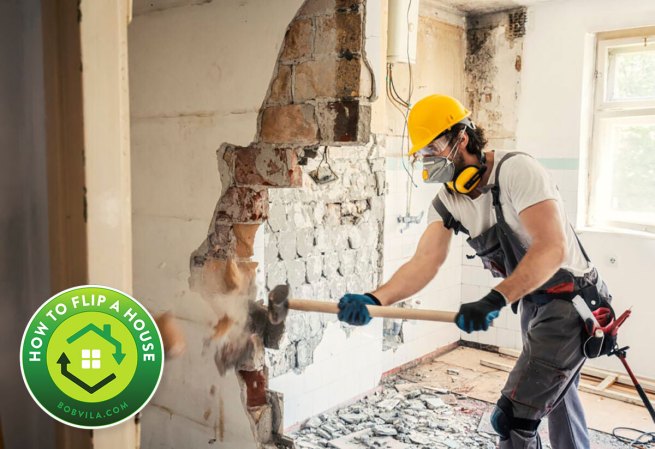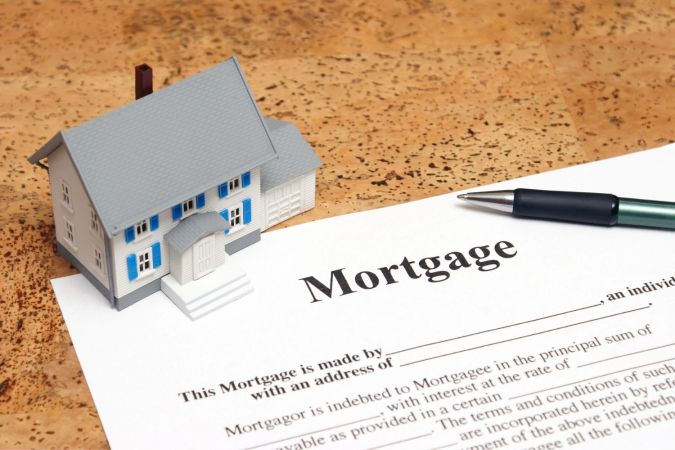We may earn revenue from the products available on this page and participate in affiliate programs. Learn More ›
Flipping houses can be a good way to make a lot of money in the right circumstances, but the barriers to entry are often significant. Successful house flippers need to be able to assess housing markets, accurately predict home valuations, and have the professional connections or skills to handle renovations—and that’s before addressing the issue of money.
Flipping a house requires a significant up-front investment in order to buy the property and pay for home renovations. Even with financing provided by a traditional mortgage lender, house flippers could owe a large down payment before their loan is processed and the home sale is finalized. Most people don’t have tens or hundreds of thousands of dollars on hand to cover the costs of mortgage down payments and home improvement projects. Even so, a lack of funds doesn’t necessarily need to stand in the way of someone looking to jump into the house flipping market. With the right approach, it’s possible to learn how to flip houses with no money down at all.
Before You Begin…
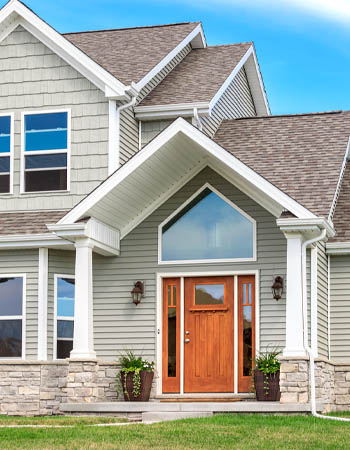
Flipping a house is a major undertaking for even experienced real estate investors, so it’s worth understanding how to flip a house before addressing the finances involved. House flippers buy homes with a lot of potential—often due to their location—but may be unappealing to buyers because they have fallen into disrepair or have outdated fixtures, layouts, and amenities. Flippers then renovate the property in order to increase its value so they can quickly resell the house at a higher price. If successful, house flippers can use the proceeds from the sale to repay any loans used to purchase the property as well as pay contractors who renovated the property—with enough money left over to make a tidy profit.
With so many moving parts, there’s a lot that can go wrong with a house flip—for instance, buying a house with major structural issues or spending too much on renovations. Reviewing house flipping tips and advice before making a purchase can help flippers avoid some common pitfalls. House flippers should also be cautious about any offers regarding free houses, as rare as they may be, since there could be significant hidden costs that may make these properties very poor investments.
Unless house flippers have enough capital on hand to fully fund the home purchase, they will need to obtain financing—and that means getting approved for a loan. Whether borrowers plan to make a significant down payment or wish to flip houses with no money down, they will be required to meet certain borrowing requirements to be eligible for a loan. Lenders may have minimum credit score requirements, for instance, which can prevent borrowers with poor credit from obtaining a house flipping loan. In other cases, lenders may only extend loans to borrowers who have flipped houses in the past. Being mindful of these kinds of lending requirements can help house flippers narrow down their options more quickly and find a financing option that suits their circumstances.
STEP 1: Research options for a short-term hard-money loan to provide capital for flipping a house.
When figuring out how to buy a house with no money for a down payment, house flippers may want to first explore their short-term hard-money loan options. Hard-money loans are secured loans—that is, they use collateral to minimize the financial risk for the lender. In terms of house flipping, the purchased property will serve as collateral for a hard-money loan, rather than the borrower’s primary residence.
Some hard-money lenders specialize in house flipping loans, which can make them an ideal source of financing for borrowers looking to buy, rehab, and sell a home. While interest rates will almost certainly be higher than those for a conventional home loan, hard-money loans are typically approved, processed, and funded more quickly than mortgages. As such, borrowers can get the money they need to cover their purchase and renovation expenses without jumping through as many hoops or going through a lengthy loan approval process.
Loan terms tend to be much shorter on a hard-money loan compared with a traditional mortgage, as well. Rather than give borrowers decades to repay their loan, hard-money lenders often expect full repayment within 12 months of origination. With such a tight window to work in, house flippers may want to be sure that they have contractors lined up and a clear timeline for completing renovations before sorting out their financing.
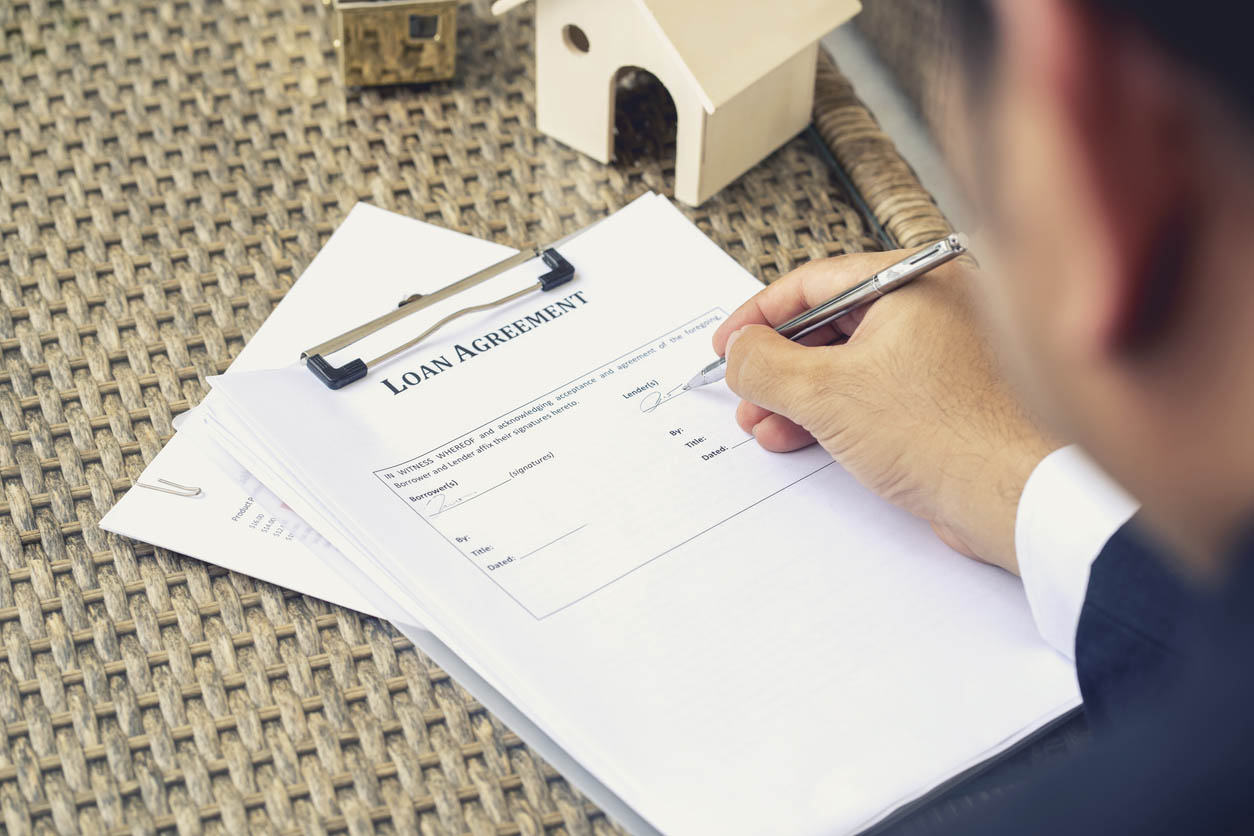
STEP 2: Check into private lenders, who may be able to provide money more quickly than hard-money lenders.
Hard-money lenders work more quickly than conventional mortgage lenders, but there’s still a wait time for loans to be approved and funded. If house flippers want to move quickly on a new listing that has just appeared on the market, even waiting a couple of days to secure financing could mean losing out on the property to buyers with more financial flexibility. In those situations, a flipper may want to turn to a private lender who can provide financial support without requiring loan underwriting.
Private lenders are often individuals who have a lot of capital on hand and who may be looking to make extra money from loan interest. Because they are not beholden to underwriting guidelines, regulatory constraints, or strict loan approval processes, private lenders may be able to quickly provide the money needed to purchase property and renovate the home so it can be resold at a profit.
In addition, private lenders may not require any kind of down payment or collateral in return for extending a loan. Other typical borrower criteria, such as credit scores, debt-to-income (DTI) ratios, and income history, may not factor into their lending decision at all. On the other hand, borrowers should be aware that private lenders can choose to charge higher interest rates than hard-money lenders and other financial institutions, so house flippers could wind up spending more on financing in the long run by going this route.
STEP 3: Look into wholesaling if a hard-money or private loan isn’t an option.
Finding a private lender or hard-money lender could be difficult for house flippers who are just starting out in this particular area of real estate investment. Wholesaling could be a good alternative if newcomers are looking to dip their toe into house flipping—so long as they are OK taking less profit than with a true fix and filp.
A wholesale transaction works by first finding a listing with a motivated seller. The house could be distressed or in foreclosure, and the seller may be looking to find a buyer as quickly as possible. The buyer then submits a contract agreeing to purchase the property—often at a price well below market value and with the stipulation that payment be made in full within a short period of time. Once the contract is signed, the buyer finds a third-party real estate investor to purchase the property and take ownership of the title. That investor will pay the original seller directly and then tackle the work to renovate the property and do a flip on their own. In exchange for facilitating this transaction, the original buyer will receive a finder’s fee from the investor, which will likely be substantially less than the amount they could have potentially made from fixing and flipping the house themselves.
Although there’s less money to be made with a wholesale purchase, house flippers don’t need to worry about the logistics of rehabbing the property either. A wholesale transaction doesn’t involve any renovation work—at least not from the original buyer. In addition, there are no lending requirements to meet because the flipper doesn’t need to take out a loan. As such, this could be a viable option for house flippers who lack the experience or credit to qualify for a hard-money loan, as well as flippers who are unable to find private lenders willing to finance a flip.

STEP 4: Search for a real estate investor to provide the funds to purchase and renovate a house in exchange for a cut of the sale profit.
Not all real estate investors are looking to make money from loan interest. Some may prefer to fund a house flip in exchange for a cut of the profit when the renovated home is sold. The relationship between the house flipper and the real estate investor may be similar to that of a buyer and a private lender, with the investor providing the funds and the flipper handling the logistics of purchasing, rehabbing, and selling the property. The major difference is how the investor is compensated for their financing. They may request a certain percentage of the final sale price or a flat fee to be taken from the flipper’s profits in lieu of interest payments.
When using a real estate investor or private lender for financing, it can be important for house flippers to bring their own specialized expertise to the relationship. That could be experience with conducting home renovations; a familiarity with particular housing markets; or strong connections with contractors, real estate agents, and other professionals who will be instrumental in facilitating the house flip. Some investors may also want to influence the renovation with their own ideas regarding how to best increase the property’s market value and sale price. This can lead to potential issues during the renovation stage if both parties can’t agree on the best way to proceed, so it may be worth taking into consideration how involved an investor wishes to be before going to them for house flipping capital.
STEP 5: Ask lenders whether you qualify for a home equity loan or line of credit to finance the house flip.
Homeowners who have accumulated significant equity in their own house may be able to tap into that equity to help pay for a house flip. Home equity loans often feature lower interest rates than unsecured loans, which can reduce the total investment cost for the flipper. However, these loans may require more time to approve and fund, making them unsuitable for flippers looking for quick financing options. Another potential obstacle is that some lenders may not approve home equity loans that will be used to invest in real estate. Not all companies will require borrowers to state the loan’s purpose, but it’s a potential obstacle to consider.
A home equity line of credit (HELOC) could be another option to explore. HELOCs also convert a borrower’s home equity into usable funds, but that money is made available through a revolving line of credit instead of a lump-sum deposit. Once the line of credit is open, borrowers can withdraw funds as needed at their own discretion. A HELOC could be useful for paying renovation costs, in particular, since house flippers may not know exactly how much money they will need to pay contractors, and they can use their HELOC to cover costs as they arise.
STEP 6: Check into real-estate-specific crowdfunding sites to provide the funds needed to buy and flip the property.
Crowdfunding is a fairly new approach to real estate investing and, in particular, house flipping. Rather than receive funds from a single lender or investor, house flippers can have their projects funded by numerous investors, each providing a small portion of the money needed to purchase and rehab a home. Crowdfunding is popular with retail investors who are just learning how to flip money since the investment costs are often very low. This approach can be mutually beneficial, with investors often getting a decent return on their investment and the house flipper receiving the financing to fund their reclamation project.
These transactions are managed through dedicated crowdfunding websites, which match investors with different investment opportunities such as house flips. Prospective borrowers may even come across dedicated house flipping loans that are funded directly through crowdfunding sites.
Crowdfunding a house flip has certain advantages. For one, lenders that use crowdfunding often offer lower interest rates than other hard-money lenders, which can help lower the total cost of flipping a house. Crowdfunding-based lenders may have more lenient borrower criteria, so house flippers could secure a loan even if they have a low credit score or high DTI ratio. Funding time frames can also be relatively short, allowing flippers to get the money needed to complete a home purchase in a matter of days in some cases.

STEP 7: Ask the home seller if they would be willing to finance the home sale and flip in exchange for a percentage of the profits.
If hard-money lenders, private lenders, real estate investors, and crowdfunding sites have all been eliminated from consideration, house flippers still have a couple of options to explore. It may seem unlikely, but house flippers may be able to get the home seller to finance the purchase and renovation of their own property and fund that flip. In fairness, owner financing is a bit unconventional when it comes to funding a house flip, but in the right circumstances, sellers may be open to this kind of transaction. For instance, a seller whose house has been sitting on the market for a very long time may be more inclined to consider an owner-financed house flip.
With owner financing, the original homeowner acts as the lender, providing the buyer with the funds for the home purchase and renovation. Depending on the terms of the agreement, the flipper will make regular payments to the seller just as they would with a conventional loan provider. This arrangement may offer more flexibility in terms of the loan conditions. The two sides are free to negotiate every detail from the interest owed on the loan to the repayment timeline. Another benefit with owner financing is that house flippers do not need to meet any strict borrower requirements regarding their credit history or existing debt. It may be a bit of a long shot, but owner financing could be worth exploring if other options are unavailable.
STEP 8: Consider a lease option where you pay rent on the home and agree to purchase it once the renovations are complete.
Another unconventional approach to flipping a house with no money is to lease the property rather than immediately buy it outright. Going this route requires a highly specialized lease agreement in which the tenant agrees to purchase the property after a certain amount of time has passed. An obvious concern here is that house flippers may need to wait a while before the property changes hands and they can sell the home themselves, delaying any profit they could stand to gain. That being said, the seller may allow them to make renovations while they rent out the property, so the rehab process can proceed without delay.
House flippers may also be concerned about paying rent on a second property when they already have a primary residence to pay for and other financial obligations to meet. These lease agreements could stipulate that any rent payments made will be applied to the purchase of the property once the lease period expires. Including that language in the agreement can help ease concerns about balancing house flipping costs with the tenant’s other monthly expenses.
Lacking the funds to make a significant down payment on a house or pay contractors for major home renovations doesn’t necessarily shut the door on an individual’s house flipping prospects. There are many alternative approaches to financing a house flip that don’t require any money up front. These financing options may seem unconventional at first glance, but they can help first-time flippers get some experience under their belt and earn their first payday flipping a house. Once they have established a track record flipping houses and have put some money in the bank, it may be easier to qualify for some of the best loans for flipping houses so they can finance one more flip—or several, as the case may be.


